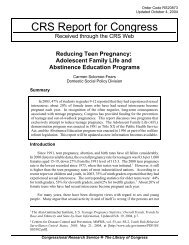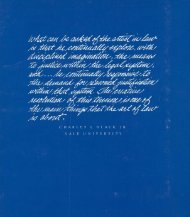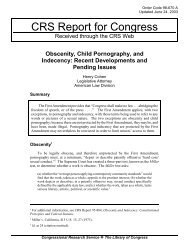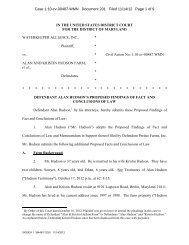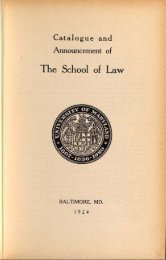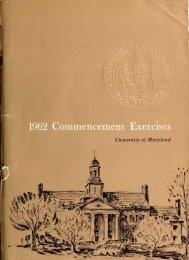- Page 1: MARYLAND JOURNAL OF INTERNATIONAL L
- Page 5: MARYLAND JOURNAL OF INTERNATIONAL L
- Page 8 and 9: 2 MD. JOURNAL OF INTERNATIONAL LAW
- Page 12 and 13: 6 MD. JOURNAL OF INTERNATIONAL LAW
- Page 14 and 15: 8 MD. JOURNAL OF INTERNATIONAL LAW
- Page 16 and 17: 10 MD. JOURNAL OF INTERNATIONAL LAW
- Page 18 and 19: 12 MD. JOURNAL OF INTERNATIONAL LAW
- Page 20 and 21: 14 MD. JOURNAL OF INTERNATIONAL LAW
- Page 22 and 23: 16 MD. JOURNAL OF INTERNATIONAL LAW
- Page 24 and 25: 18 MD. JOURNAL OF INTERNATIONAL LAW
- Page 27 and 28: K MART V. CARTIER: THE SUPREME COUR
- Page 29 and 30: 1990] K MART v. CARTIER mon ownersh
- Page 31 and 32: 19901 K MART v. CARTIER created by
- Page 33 and 34: 1990] K MART v. CARTIER ered to be
- Page 35 and 36: 1990] K MART v. CARTIER his concurr
- Page 37 and 38: 1990] K MART v. CARTIER may not use
- Page 39 and 40: 1990] K MART v. CARTIER Finally, th
- Page 41 and 42: 1990] K MART v. CARTIER protection
- Page 43 and 44: 19901 K MART v. CARTIER pie, Maryla
- Page 45 and 46: 1990] K MART v. CARTIER require tha
- Page 47: 19901 K MART v. CARTIER reconcile w
- Page 50 and 51: 44 MD. JOURNAL OF INTERNATIONAL LAW
- Page 52 and 53: 46 MD. JOURNAL OF INTERNATIONAL LAW
- Page 54 and 55: 48 MD. JOURNAL OF INTERNATIONAL LAW
- Page 56 and 57: 50 MD. JOURNAL OF INTERNATIONAL LAW
- Page 58 and 59: 52 MD. JOURNAL OF INTERNATIONAL LAW
- Page 60 and 61:
54 MD. JOURNAL OF INTERNATIONAL LAW
- Page 62 and 63:
56 MD. JOURNAL OF INTERNATIONAL LAW
- Page 64 and 65:
58 MD. JOURNAL OF INTERNATIONAL LAW
- Page 66 and 67:
60 MD. JOURNAL OF INTERNATIONAL LAW
- Page 68 and 69:
62 MD. JOURNAL OF INTERNATIONAL LAW
- Page 70 and 71:
64 MD. JOURNAL OF INTERNATIONAL LAW
- Page 72 and 73:
66 MD. JOURNAL OF INTERNATIONAL LAW
- Page 74 and 75:
68 MD. JOURNAL OF INTERNATIONAL LAW
- Page 76 and 77:
70 MD. JOURNAL OF INTERNATIONAL LAW
- Page 78 and 79:
72 MD. JOURNAL OF INTERNATIONAL LAW
- Page 81 and 82:
NOTE GREGORIAN v. IZVESTIA: AN ANAL
- Page 83 and 84:
1990] GREGORIAN v. IZVESTIA of the
- Page 85 and 86:
19901 GREGORIAN v. IZVESTIA cution.
- Page 87 and 88:
1990] GREGORIAN v. IZVESTIA the lib
- Page 89 and 90:
1990] GREGORIAN v. IZVESTIA II. STA
- Page 91 and 92:
1990] GREGORIAN v. IZVESTIA Section
- Page 93 and 94:
1990] GREGORIAN v. IZVESTIA bia, th
- Page 95 and 96:
1990] GREGORIAN v. IZVESTIA rule. C
- Page 97 and 98:
1990] GREGORIAN v. IZVESTIA the fin
- Page 99 and 100:
1990] GREGORIAN v. IZVESTIA munist
- Page 101 and 102:
1990] GREGORIAN v. IZVESTIA hands o
- Page 103 and 104:
1990] GREGORIAN v. IZVESTIA viet St
- Page 105 and 106:
NOTE THE ROLE OF INTERNATIONAL LAW
- Page 107 and 108:
1990] INT'L LAW IN DOMESTIC COURTS
- Page 109 and 110:
1990] INT'L LAW IN DOMESTIC COURTS
- Page 111 and 112:
19901 INT'L LAW IN DOMESTIC COURTS
- Page 113 and 114:
19901 INT'L LAW IN DOMESTIC COURTS
- Page 115 and 116:
19901 INT'L LAW IN DOMESTIC COURTS
- Page 117 and 118:
1990] INT'L LAW IN DOMESTIC COURTS
- Page 119 and 120:
1990] INT'L LAW IN DOMESTIC COURTS
- Page 121 and 122:
1990] INT'L LAW IN DOMESTIC COURTS
- Page 123 and 124:
1990] INT'L LAW IN DOMESTIC COURTS
- Page 125 and 126:
1990] INT'L LAW IN DOMESTIC COURTS
- Page 127 and 128:
19901 INT'L LAW IN DOMESTIC COURTS
- Page 129 and 130:
1990] INT'L LAW IN DOMESTIC COURTS
- Page 131:
1990] INT'L LAW IN DOMESTIC COURTS
- Page 134 and 135:
128 MD. JOURNAL OF INTERNATIONAL LA
- Page 136 and 137:
130 MD. JOURNAL OF INTERNATIONAL LA
- Page 138 and 139:
132 MD. JOURNAL OF INTERNATIONAL LA
- Page 140 and 141:
134 MD. JOURNAL OF INTERNATIONAL LA
- Page 142 and 143:
136 MD. JOURNAL OF INTERNATIONAL LA
- Page 144 and 145:
138 MD. JOURNAL OF INTERNATIONAL LA
- Page 146 and 147:
140 MD. JOURNAL OF INTERNATIONAL LA
- Page 148 and 149:
142 MD. JOURNAL OF INTERNATIONAL LA
- Page 150 and 151:
144 MD. JOURNAL OF INTERNATIONAL LA
- Page 153 and 154:
BOOKS RECEIVED RESISTING PROTECTION
- Page 155 and 156:
1990) BOOKS RECEIVED COFFEE AND DEM
- Page 157 and 158:
1990] BOOKS RECEIVED THE TAIWAN REL
- Page 159 and 160:
1990] BOOKS RECEIVED WORLD ECONOMIC
- Page 161 and 162:
1990] BOOKS RECEIVED TREATY CONFLIC
- Page 163 and 164:
1990] BOOKS RECEIVED HUMAN RIGHTS A
- Page 165 and 166:
1990] BOOKS RECEIVED HONG KONG COUN
- Page 167 and 168:
ARTICLES FOREIGN CORRUPT PRACTICES
- Page 169 and 170:
1990] FOREIGN CORRUPT PRACTICES ACT
- Page 171 and 172:
1990] FOREIGN CORRUPT PRACTICES ACT
- Page 173 and 174:
1990] FOREIGN CORRUPT PRACTICES ACT
- Page 175 and 176:
1990] FOREIGN CORRUPT PRACTICES ACT
- Page 177 and 178:
1990] FOREIGN CORRUPT PRACTICES ACT
- Page 179 and 180:
1990] FOREIGN CORRUPT PRACTICES ACT
- Page 181 and 182:
UNITED STATES v. VERDUGO-URQUIDEZ,
- Page 183 and 184:
1990] U.S. v. VERDUGO-URQUIDEZ bein
- Page 185 and 186:
1990] conduct had to be excessive.
- Page 187 and 188:
1990] U.S. v. VERDUGO-URQUIDEZ supp
- Page 189 and 190:
1990] U.S. v. VERDUGO-URQUIDEZ Verd
- Page 191 and 192:
1990] US. v. VERDUGO-URQUIDEZ Unite
- Page 193 and 194:
1990] U.S. v. VERDUGO-URQUIDEZ vali
- Page 195 and 196:
1990] U.S. v. VERDUGO-URQUIDEZ tion
- Page 197 and 198:
1990] U.S. v. VERDUGO-URQUIDEZ disr
- Page 199 and 200:
1990] U.S. v. VERDUGO-URQUIDEZ IV.
- Page 201 and 202:
COMMENT THE UNITED STATES' 1986 EME
- Page 203 and 204:
1990] SANCTIONS AGAINST LIBYA Reaga
- Page 205 and 206:
1990] SANCTIONS AGAINST LIBYA power
- Page 207 and 208:
1990] SANCTIONS AGAINST LIBYA 1. No
- Page 209 and 210:
1990] SANCTIONS AGAINST LIBYA ments
- Page 211 and 212:
1990] SANCTIONS AGAINST LIBYA d'Aff
- Page 213 and 214:
1990] SANCTIONS AGAINST LIBYA sion
- Page 215 and 216:
1990] SANCTIONS AGAINST LIBYA 2. Pr
- Page 217 and 218:
1990] SANCTIONS AGAINST LIBYA On Ju
- Page 219 and 220:
1990] SANCTIONS AGAINST LIBYA (b) E
- Page 221 and 222:
19901 SANCTIONS AGAINST LIBYA ulate
- Page 223 and 224:
1990] SANCTIONS AGAINST LIBYA permi
- Page 225 and 226:
1990] SANCTIONS AGAINST LIBYA illeg
- Page 227 and 228:
1990] SANCTIONS AGAINST LIBYA FIGUR
- Page 229 and 230:
19901 SANCTIONS AGAINST LIBYA FIGUR
- Page 231 and 232:
1990] SANCTIONS AGAINST LIBYA Prohi
- Page 233 and 234:
1990] SANCTIONS AGAINST LIBYA larat
- Page 235 and 236:
1990] SANCTIONS AGAINST LIBYA incom
- Page 237 and 238:
1990] SANCTIONS AGAINST LIBYA a. Ta
- Page 239 and 240:
NOTE REEVALUATING THE "CORPORATE VE
- Page 241 and 242:
1990] HESTER v. FED. REPUBLIC OF NI
- Page 243 and 244:
1990] HESTER v. FED. REPUBLIC OF NI
- Page 245 and 246:
1990] HESTER v. FED. REPUBLIC OF NI
- Page 247 and 248:
1990] HESTER v. FED. REPUBLIC OF NI
- Page 249 and 250:
1990] HESTER v. FED. REPUBLIC OF NI
- Page 251 and 252:
1990] HESTER v. FED. REPUBLIC OF NI
- Page 253 and 254:
1990] HESTER v. FED. REPUBLIC OF NI
- Page 255:
19901 HESTER v. FED. REPUBLIC OF NI
- Page 258 and 259:
252 MD. JOURNAL OF INTERNATIONAL LA
- Page 260 and 261:
254 MD. JOURNAL OF INTERNATIONAL LA
- Page 262 and 263:
256 MD. JOURNAL OF INTERNATIONAL LA
- Page 264 and 265:
258 MD. JOURNAL OF INTERNATIONAL LA
- Page 266 and 267:
260 MD. JOURNAL OF INTERNATIONAL LA
- Page 268 and 269:
262 MD. JOURNAL OF INTERNATIONAL LA
- Page 270 and 271:
264 MD. JOURNAL OF INTERNATIONAL LA
- Page 273 and 274:
BOOKS RECEIVED PRIVATIZATION AND ST
- Page 275 and 276:
1990] BOOKS RECEIVED RIGHT v. MIGHT
- Page 277 and 278:
1990] BOOKS RECEIVED LAW UNDER STRE
- Page 279:
1990] BOOKS RECEIVED 273 factions p



